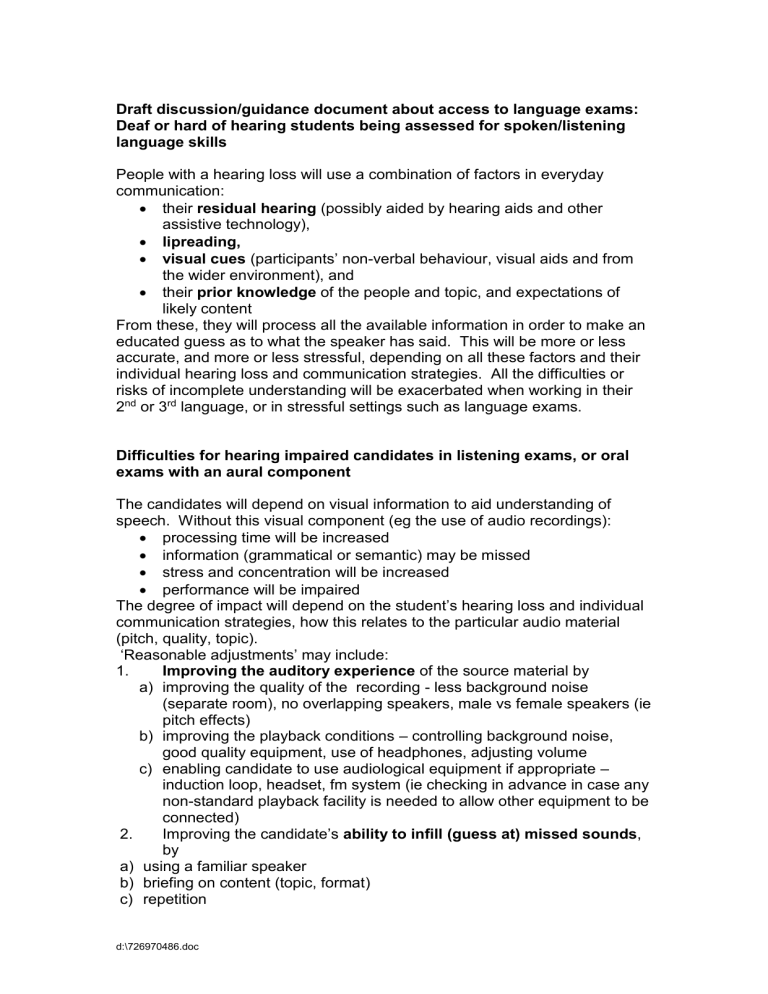Assessment of Deaf Students Work - general guidance for aural and

Draft discussion/guidance document about access to language exams:
Deaf or hard of hearing students being assessed for spoken/listening language skills
People with a hearing loss will use a combination of factors in everyday communication:
their residual hearing (possibly aided by hearing aids and other assistive technology),
lipreading,
visual cues (participants’ non-verbal behaviour, visual aids and from the wider environment), and
their prior knowledge of the people and topic, and expectations of likely content
From these, they will process all the available information in order to make an educated guess as to what the speaker has said. This will be more or less accurate, and more or less stressful, depending on all these factors and their individual hearing loss and communication strategies. All the difficulties or risks of incomplete understanding will be exacerbated when working in their
2 nd or 3 rd language, or in stressful settings such as language exams.
Difficulties for hearing impaired candidates in listening exams, or oral exams with an aural component
The candidates will depend on visual information to aid understanding of speech. Without this visual component (eg the use of audio recordings):
processing time will be increased
information (grammatical or semantic) may be missed
stress and concentration will be increased
performance will be impaired
The degree of impact will depend on the student’s hearing loss and individual communication strategies, how this relates to the particular audio material
(pitch, quality, topic).
‘Reasonable adjustments’ may include:
1. Improving the auditory experience of the source material by a) improving the quality of the recording - less background noise
(separate room), no overlapping speakers, male vs female speakers (ie pitch effects) b) improving the playback conditions
– controlling background noise, good quality equipment, use of headphones, adjusting volume c) enabling candidate to use audiological equipment if appropriate – induction loop, headset, fm system (ie checking in advance in case any non-standard playback facility is needed to allow other equipment to be connected)
2.
Improving the candidate’s ability to infill (guess at) missed sounds , by a) using a familiar speaker b) briefing on content (topic, format) c) repetition d:\726970486.doc
3. improving the candidate’s opportunity to decode and process the auditory information, by: a) pauses to allow the student some time to process previous information b) repetition of the material c) extra write-uptime
4. Adding a visual component a) use of ‘live speaker’ (best) or video so student can lipread and use visual , eg non-verbal cues, as in normal communication events. b) use of lipreading cues (eg visual aids, cued speech or other) c) NB one live speaker should be positioned against a plain background, facing the candidate, in good (neither dim nor glaring) lighting conditions.
For conversation between two language models, seating and lighting should be negotiated in advance.
Oral exams, seminar or language class participation
Any difficulty with hearting and understanding examiner questions or other students’ contributions will impact on the candidate’s own production.
The candidate needs to see all speakers, from the start of their contribution, ie turn-taking needs to be controlled.
Context of the exam
Invigilator announcements or examiner briefings to students (such as on the format and conduct of the exam) should be made clear to the candidate, in advance or in writing if possible, rather than creating a communication burden additional to the assessed component.
Previous arrangements with the language schools within the University have included:
Audio material of reasonable quality ie both source recording and playback facilities
Separate room
<student name> to be able to determine the volume
– possible to have a short sample of test material or other at start of tape for <her/him> to listen to before test starts.
Lack of background noise
– use of headphones <specialist/standard> or controlled quiet environment
Sample audio material to created using a familiar speaker, eg lecturer or class tutor (familiarity with their voice and vocal style).
Source material in short sections, eg slight pauses between topics/paragraphs.
Extra repetition of the material
Extra write-up time
Examples
Student A
Listening exam d:\726970486.doc
Original task
Listen to audio material 1 st time, 5 minutes for notes.
Listen to material 2 nd (final) time
– 20 minutes for written task.
Adjusted task
The exam material was newly produced (for all students) using a spoken presentation by a staff member familiar for Student A.
Separate room, Student A able to adjust the volume.
Listen to audio material twice, each time with 3-4 pauses at topic breaks for 20-30 seconds. 5 minutes to make notes.
Listen to material straight through for 3 rd (final) time. 20 minutes + 25% extra time for written task.
Student B
Listening & oral exams, presentations & seminar participation
1. Students are examined on their spoken language choice individually.
Examiners will be reminded before these exams of <student name> hearing difficulties.
2. There is a listening comprehension for the XXX language module. This is in MP3 format, so <student name> will be able to listen to the file on headphones in <his/her> teacher’s office.
3. Staff are to ensure that <student name> can sit near them in grammar classes, and they will repeat answers.
4. <student name> will speak to <his/her> fellow students to ask that some of the group discussions in oral classes (especially those in which <s/he> has to give a presentation) are more carefully controlled, i.e. students raise their hands if they wish to speak.
Student C
Listening exam
Separate room
‘live speaker’ – staff member read the transcript of the audio-material, direct to the student. As this was a member of dept staff, an additional invigilator was not used.
1x extra reading out of the source text.
Sheenagh Hull
November 2007 d:\726970486.doc





